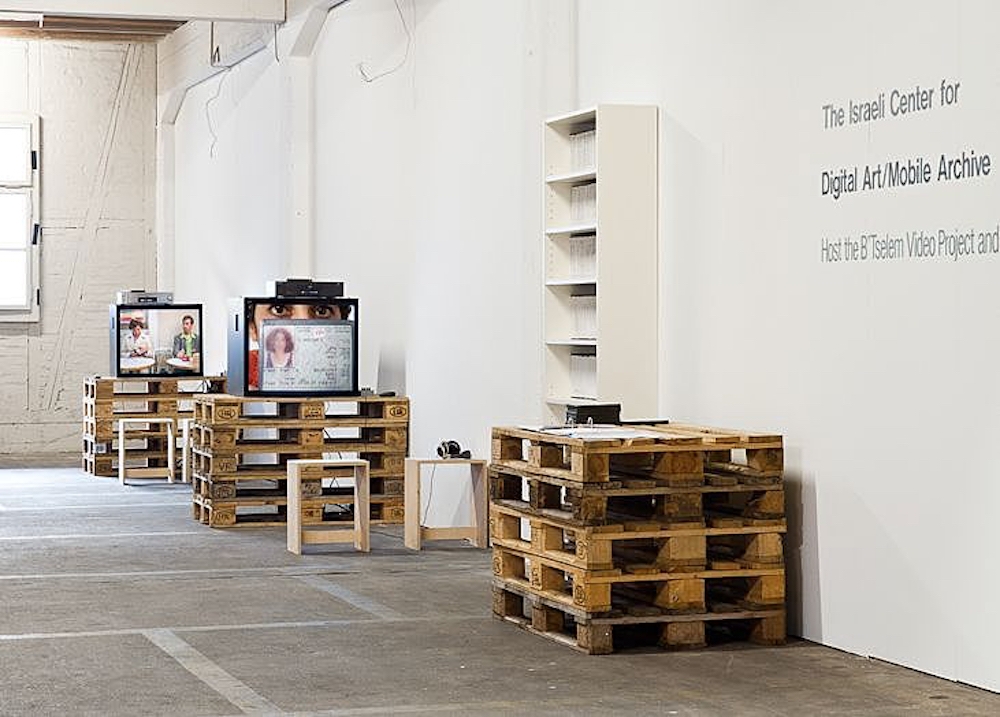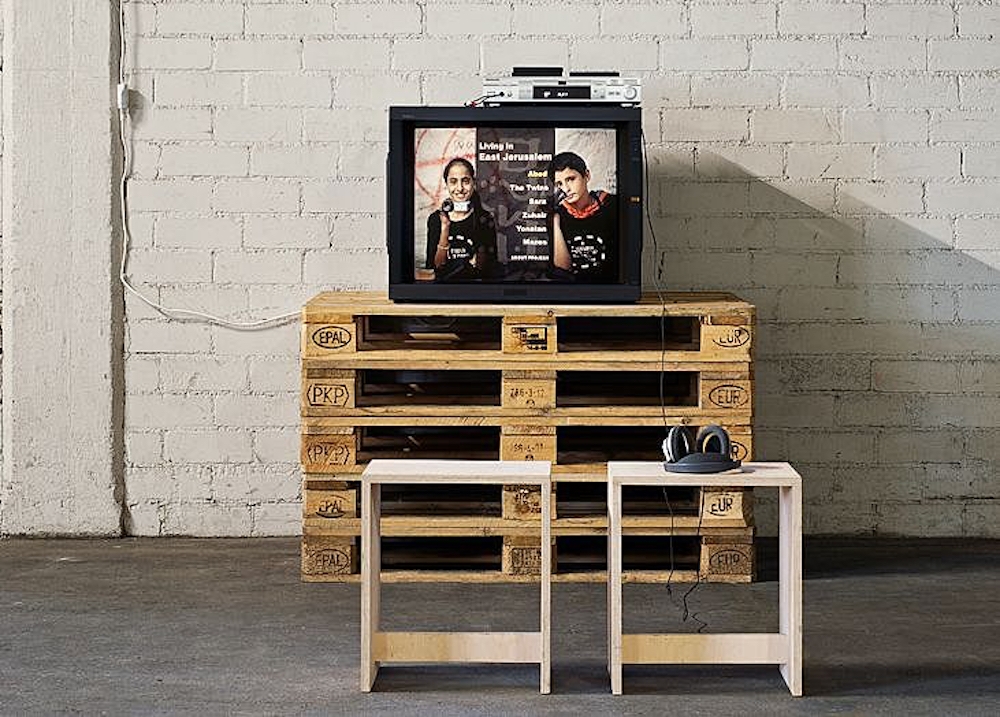The Israeli Center for Digital Art / Mobile Archive
B'Tselem Video Project and HEB2
21.9. —
16.10.2011


One of the most important Israeli institutions for digital art is the Israeli Center for Digital Art, whose mobile archive will be on show during the exhibition at Kunsthaus Baselland “im Dreispitz”. In addition, the Israeli Center for Digital Art has invited two guests from the West Bank, the B’tselem Video Project and HEB2, who will present their work on Sunday, 25 September, from 13-17 hrs.
The Israeli Center for Digital Art, Holon is a dynamic platform for researching, producing and analyzing contemporary art, as well as providing a meeting point for exchange between contemporary artists, curators, critics and the public. The center is a non-profit organization supported by the city of Holon. As a public art space it constantly questions the place of art and art institutions within their society. This brings to the front political and social issues art should not be ignoring. In an effort to stimulate discourse in Israeli society, the center devotes a significant part of its work on art projects that foster questions about identity, ethnicity, nationalism and cultural exchange.
The Israeli Center for Digital Art is the first exhibition space in Israel dedicated to presenting media art. The Center's Video Archive makes media art more accessible to researchers, curators, students and art lovers. It contains about 2500 titles, including video art, sound art, film, documentation of performances and installations that have been exhibited at the center, as well as other works by leading Israeli and international artists. Many of the works reflect the thematical curatorial line of the center through questions of identity, militarism, and nationalism, as well as other socio-political issues relevant to our region.
The Mobile Archive is a portable version of the archive in Holon. It has been traveling the world for the past four years, presenting already in twelve different venues in America and Europe before reaching Basel. The Mobile Archive is a flexible project designed to adapt itself to each host (venue) and to the local audience so its presentation is never the same. Every hosting institution can contribute works to the original collection and send it along in its extended version so that its collection keeps on growing from station to station.The project was initiated by Eyal Danon, Galit Eilat (The Israeli Center for Digital Art) and Eva Birkenstock (Kunstverein, Hamburg).
HEB2 is an audio-visual production and research initiative in and about the divided city of Hebron, West Bank - specifically within the militarized, Israeli-controlled sector known as 'H2'. A unique political, geographical, and demographical entity in the region, H2 Hebron is home to an enclave of radical Jewish settlers entrenched in the midst of a predominantly Arab-Muslim population. Arguably the most violent and volatile friction point in the Israeli-Palestinian conflict, H2 Hebron is a locus of competing national, religious, and territorial agendas. For the past four years, the HEB2 project has sought to document, engage, as well as intervene in the political, cultural, and spatial relations between Arabs and Jews in H2 Hebron. HEB2 employs a range of interconnected artistic practices: live, web-based television broadcasting; community-based, 'amateur video' production; architectural/spatial intervention; and photographic, 'archaeological' investigation. Both research tools and products in and of themselves, these methodologies are all aimed towards a mapping of a visual and human environment that is at once both historically specific as well as emblematic of broader, national and global condition. The heart of the project has been the establishment of a community-based media centre in an abandoned Palestinian house directly adjacent to the Tel Rumeida settlement in H2. Previously used as an army control point and sniper post, the centre serves as a training facility for video workshops and seminars as well as a neighborhood activity space for the community. The HEB2 Centre is also the home base for HEB2's two video platforms: HEB2.TV, an online video streaming channel running occasional live broadcasts from within H2 Hebron; and 'Hebron Home Movies', through which HEB2 works with local Palestinian residents on producing their own video materials. These two projects have together yielded a vast video archive, spanning four years and more than thirty contributors - a unique documentation of political, cultural, and personal life in present-day Hebron.
Mich’ael Zupraner: Personally, the choice to focus on H2 Hebron is in part an attraction to an extreme. In the wake of mutual Arab-Jewish violence and crippling Israeli military policies, present-day, post-Intifada H2 Hebron is a heavily militarized, depopulated zone. Palestinian residents, by direct or implicit pressure, have fled many of the homes, stores, and streets surrounding the Jewish settlements - leaving a 'ghost town' in the heart of the city. Seen as such, Hebron seems allegorical, even prophetic - a worst-case scenario for other ethnically-mixed cities (such as Jerusalem or Akko) and a nightmarish vision for Arab-Jewish coexistence at large. Taken beyond the particulars of the Israeli-Palestinian conflict, H2 Hebron can also be framed as a collision point for a set of global, real or perceived negations - The Developing World and the West; Islam and the Judeo-Christian tradition; Colonialist expansion and anti-Colonialist struggle; and so forth. But beyond such dichotomous interpretation, I see in Hebron a far more nuanced, far more rare meeting point of these same oppositions and their agents. Daily, individual interactions between Arabs and Jews in Hebron - civilians, settlers, soldiers, and artists alike - are often tamer, more complex exchanges than one would expect. Contradictions and conflicts play out incessantly; but rather than combusting, they usually only go so far as to reveal themselves. Such a 'laboratory' in which Israeli-Palestinian interactions can be observed is, ironically, hard to find outside of the city; The Occupied Territories are becoming increasing segregated, the occupation itself ever more sterilized, impersonal. In Hebron - despite the rigid, racial policies that divide its residents from one another - there still exists the potential for interpersonal interaction, an honest though often painful discursive space between two communities in conflict. It is at that proximity of subjective individual experience and interpersonal interaction that I work, that is my focus, and which I believe is most telling of the larger contexts in which Hebron is situated.
The Presentation at Kunsthaus Baselland “im Dreispitz”: Mich'ael Zupraner, co-founder and artistic director of HEB2, will discuss his experience living and working in H2 Hebron, the selections he's made for the exhibition, as well as show some of the project's most recent output.
About B'Tselem Camera Project: In 2007, B'Tselem’s Video Department launched its camera project, in which the organization distributes video cameras to Palestinians living in areas in the West Bank, East Jerusalem, and the Gaza Strip. The cameras enable them to present the reality of their lives to the Israeli and international public, thereby encouraging action to improve the situation. The project is unique in that it enables Palestinians themselves to document the infringement of their rights and to present their daily lives, their anger, pain, joy, and hope to Israelis who live so close and yet so far away from them. The hundreds of volunteers film a reality that the Israeli public is usually unaware of. The video footage, together with the footage of security cameras set up at locations where violence is common, provides additional documentation. The unlawful shooting of a bound and blindfolded Palestinian demonstrator, daily harassment by settlers in Hebron, attacks on Palestinian farmers in the southern Hebron hills, and army incursions into Qalqiliya are just some of the events that have already been filmed and distributed thanks to the project. Footage taken by the volunteers is frequently broadcast by Israeli and international media, exposing to a large audience incidents that previously remained concealed. B'Tselem uses the footage as a basis for its complaints to the army and the police following suspected breaches of the law by security forces. In some cases, the footage provides vital evidence in legal proceedings. In a few cases, broadcast of the footage has contributed to genuine policy changes.
Presentation at Kunsthaus Baselland “im Dreispitz”: In their presentation, Noam Raz and Iyad Haddad, a field researcher and citizen journalist for B’Tselem, will introduce B'Tselem's pragmatic model of citizen journalism and the different ways it uses video to encourage legal accountability, influence government policies and spark a debate in a conflicted society. They will screen various examples of footage filmed daily by volunteers from all over the West Bank and Gaza, ranging from cave dwellers in South Hebron who film clashes with settlers, to citizen journalists footage documenting the popular protest against the building of the separating barrier in Bil’in. Mr.Haddad, who works in the Ramallah area and follows the protests closely, will screen some of his own footage. Using the diverse range of videos, the presentation will supply an intimate look into the current human rights reality in the Occupied Territories, and into Palestinian daily life under occupation.
Curated by Sabine Schaschl Text by The Israeli Center for Digital Arts and Sabine Schaschl